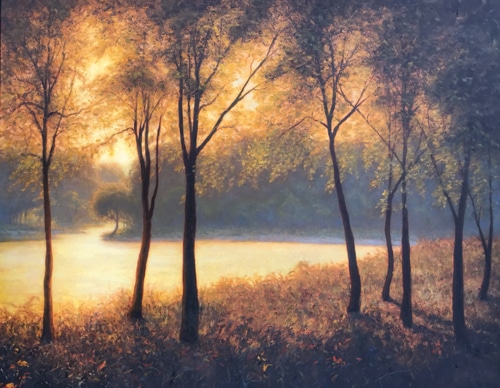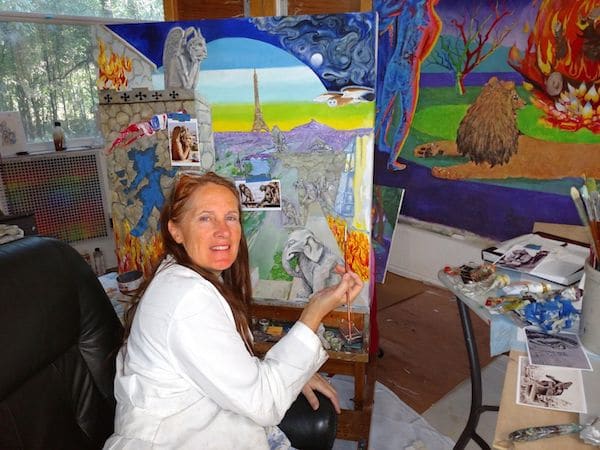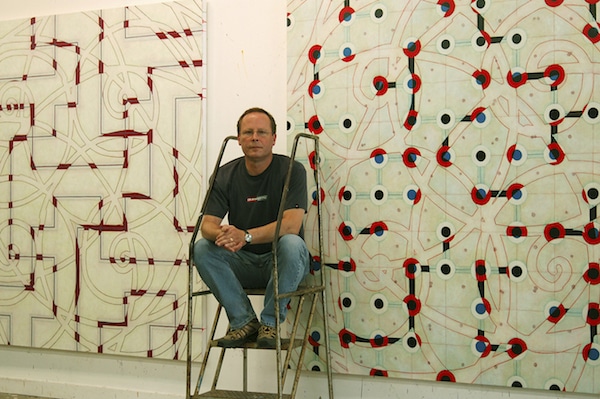 2017 Accelerator Fellow
2017 Accelerator Fellow
Where did you grow up?
I was born near Los Angeles. When I was eight, my family moved across the country to a small town in Western Massachusetts. My favorite memories are of four distinct seasons, colonial architecture, and the beautiful oak forest behind our home.
When/how did you first know that you wanted to be an artist?
I always loved drawing more than anything else. After I created a masterpiece on the living-room walls with purple crayon, my mother made sure I had plenty of paper at my disposal.
Where do you currently live/work, and how would you describe the arts community there?

I live and work in a small cabin in the woods on Bainbridge Island, Washington. Although the island has a fairly small population (approximately 20,000), it has a vibrant arts community that includes galleries, a museum, a theater, and a wide range of art events throughout the year. I enjoy the peace and quiet of living in the country, as well as the fact that downtown Seattle is only 40 minutes away by ferry.
How would you describe your art to someone who’s never seen it?
My work juxtaposes delicate lines against bold splashes of color. I’m fascinated by details. Working with an ink pen, I draw fine vertical lines to create both subtle gradation and strong contrasts to describe my subjects. Once the drawing is complete, I brush on spontaneous strokes of watercolor, letting the colors dance together. The combination draws in viewers and encourages them to discover a fresh perspective on everyday scenes.
What do you hope to communicate to your audience?
I want to convey that there’s always more to life than meets the eye. Oftentimes, there are ordinary scenes right under our noses that offer peace, harmony, and beauty.
What’s been your biggest business challenge?
All aspects of sales—pricing, finding the right galleries, closing the deal, etc.
Tell us about a business success and what you did to achieve it.
Bainbridge Island has a world-renowned public garden. Three years ago, I decided to use it as my outdoor studio and visited each week to paint. At the end of the year, I put on a show at the on-site residence and made notecards of some of my paintings from that year in the garden. In addition to the pieces I sold at the show, the cards were hugely popular. I have now created a second set of cards featuring my ink and watercolor technique, and they, too, have almost sold out.
How do you feel about today’s technology (tools for your business, for creating your art, or both), and has it altered your way of doing business?
I think it’s a huge help, especially for artists who know how to use it to its fullest potential. It’s been fun to receive comments and views from around the world via my website, blog, Facebook, and Instagram. The website provides examples of my work and information about commissions, classes, and shows, while the blog—Love-to-Draw.com—shares lessons and experiences that are intended to encourage others to discover the delight of drawing. The blog has brought in new students, sales, and even writing opportunities, so it’s been worth the time I’ve invested in it.
What do you think about the state of today’s art market?
Honestly, I don’t know enough about the broader market to comment. One of my goals is to become more involved in the Seattle art market. I would love to show my work in other regions, and I look forward to having a better answer to this question soon.
Give us an example of how you balance studio time with business time.
My goal is to spend time each Friday afternoon cleaning, filing, organizing, reviewing exhibition calls, and updating my records. Because I teach and write a weekly blog, I am often scrambling for time in which to create new work and get organized. A 30-hour day would be a big help!
How have you evolved as an artist?
In college, my favorite professor was an excellent watercolorist, and I was happy to follow in his footsteps. I later took up oil painting and still enjoy painting en plein air with oils. When I started teaching drawing a few years ago, my ink and watercolor style began to develop. I wanted to be able to show my students that drawing could be more than quick sketches—it can be fine art, too. As my style has evolved, I am experimenting with new surfaces, larger sizes, and unusual viewpoints. I love the fact that art isn’t static; it needs to grow. That keeps me moving forward in positive ways.

How have you evolved as an entrepreneur?
Quitting my day job was the best thing I ever did. Without an income to fall back on, I abandoned my comfort zone to give talks and demonstrations, teach all ages, exhibit in a variety of venues, and acquire technical skills such as creating and maintaining my website and blog. I’m stronger because I have tackled things that I might not have otherwise tried.
What role do artists play in our society? What role SHOULD they play?
Artists enrich our world by showing us how worthwhile life can be. They also make valuable comments on problems to be solved. Creative expression is vital to a successful civilization. Without art, life would be pulseless, cold, and sterile. We need art to keep us alive and thriving.
Anything else you would like us to know?
Being an artist is my dream come true. I raised three children as a single parent from the time the youngest was a baby. For nearly 20 years, I dedicated my life to them and my job, hoping there would be a place for art in my future. The day that my youngest started college, I set up a studio. I began painting on weekends, got involved with local art groups, and started exhibiting. Not long after the tuition payments were complete, I quit my job, sold my house, and focused all my efforts on art. Not a day goes by that I am not grateful to be living the artist’s life.
For more information on Paula Ensign, see her official CHF bio.








